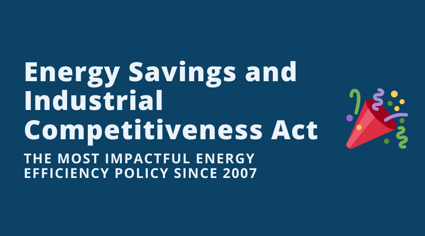
A bipartisan bill, sponsored by Senators Jeanne Shaheen (D-NH) and Rob Portman (R-OH) in the Senate and Representatives Peter Welch (D-VT) and David McKinley (R-WV) in the House, is currently being discussed in Congress. If it passes, the Energy Savings and Industrial Competitiveness Act is estimated to be the most impactful energy efficiency legislation passed since the Energy Independence and Security Act (EISA) in 2007. The EISA featured some major mandates on the efficiency standards of light bulbs that were set to go into effect on January 1, 2020 before it was halted by President Trump.
The Energy Savings and Industrial Competitiveness Act instead primarily achieves its energy savings by modifying national building codes for both residential and commercial buildings. Under this bill, the Department of Energy would work directly with State and Local governments to plan and achieve energy savings goals.
In addition to modifying building codes, this legislation would also create a program to account for energy efficiency in the mortgage appraisal process through federal housing programs, which is being referred to as the SAVE Act. Some critics of the bill have pointed out that this will make new homes less affordable to new homeowners when energy efficiency is used in evaluating the value of a new residential property. However, it will incentivize homebuilders to be more energy-efficient rather than cutting costs, knowing that those measures will be accounted for and ultimately increase value.
Another major piece of this bill is the expansion of DOE Industrial Assessment Centers (IACs), which train college students and provide energy audits, to include community colleges and trade schools. This expansion would help make energy efficiency related jobs more accessible by providing more training and resources.
According to an analysis done by ACEEE, this bill would generate over $50 billion of net energy savings, after the initial investment in the proper equipment. It is also projected to cut almost one year of US energy usage and generate 100,000 new jobs in energy efficiency. There’s still a lot to be done as this bill makes its way through Congress, but this appears to be a step in the right direction as Democrats and Republicans work together with energy efficiency in mind.
If you want to read more about this bill, you can find a briefing (or even read the bill in its entirety!) here: https://www.portman.senate.gov/newsroom/portman-shaheen-introduce-energy-efficiency-legislation
.png?width=500&name=2019%20e%20news%20spotlight%20logo%20(1).png)




